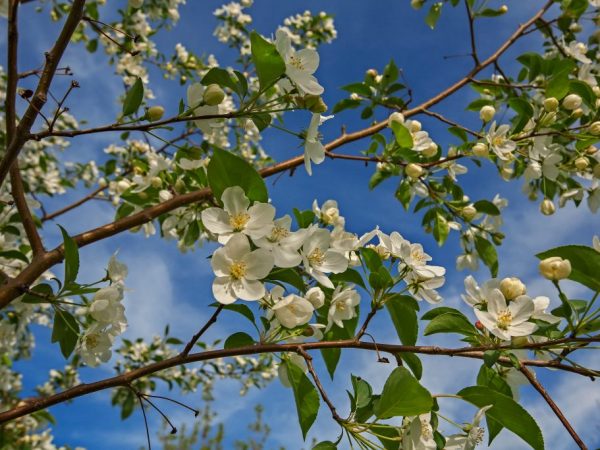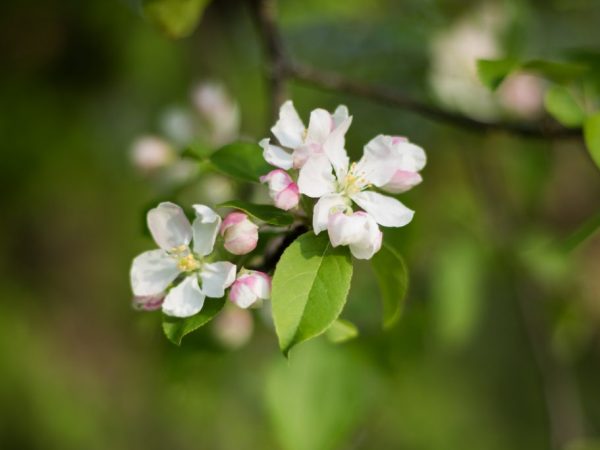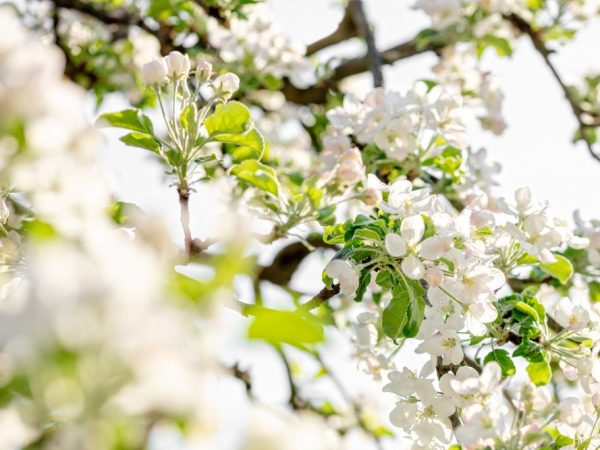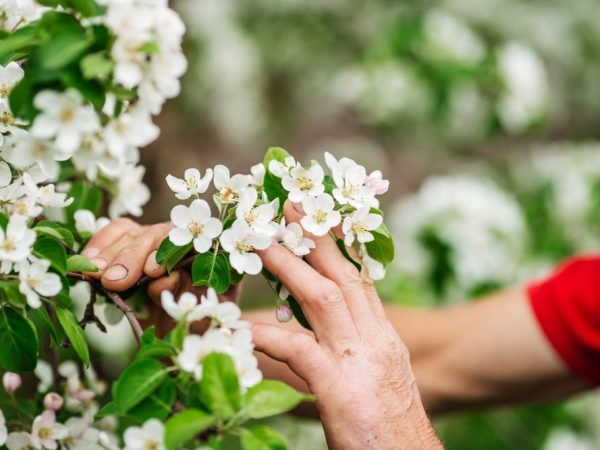How to make an apple blossom
When growing apple trees, gardeners are faced with a lack of fruiting. You can make the apple tree bear fruit if you eliminate the factors that interfere with the flowering process and the formation of fruits. There are many reasons why a fruit tree does not produce crops, and they are associated with inadequate care, violation of agricultural technology, disease and pests.
- Common Causes
- Age of culture
- Varietal affiliation
- Not suitable climate
- Lack of pollinators
- Excess ovaries
- Violation of landing
- Branch damage
- Damage by diseases and pests
- Poor pruning
- Excess and lack of mineral nutrition
- Other possible factors
- Branch growth direction
- Watering
- Return frosts
- Making the apple tree bear fruit
- Transplanting a tree
- Pollination improvement
- Regulation of dressings
- Treatments against diseases and pests
- Pruning and rationing of ovaries
- Unconventional methods
- Iron replacement
- Return frost protection
- Banding
- Summing up

How to make an apple blossom
Common Causes
There are several reasons why the apple tree does not bear fruit or even bloom. Let's consider each in more detail.
Age of culture
Sometimes gardeners, while waiting for the first fruits, do not consider the age of the tree. Remember that young seedlings should not yet yield a crop at all. This is especially true of varieties obtained from grafting on a strong rootstock.
Reaching the age of 5 is not enough for apples to appear.
Most often, the beginning of flowering and fruiting of apple trees occurs from the age of 6, and sometimes only by the age of 8.
Varietal affiliation
The peculiarities characteristic of a particular variety sometimes have a significant effect on the timing of the onset of the flowering and fruiting stages.
The fruits of the Alyi, Suislepskoe, Anis, and Solnyshko varieties yield late.
Sometimes gardeners, when growing varieties grafted onto strong rootstocks, are faced with the fact that they fade, but do not give a crop. This is called trial flowering.
Not suitable climate
All varietal varieties of fruit crops are intended for cultivation in certain climatic zones.
A tree that is not adapted for a particular region will not bear fruit at all, or it will give few apples, trying to cope with adaptation to unsuitable conditions for it.
Very often, gardeners of the northern regions of Russia try to grow late-ripening varieties on heavy soils. In such conditions, the crop is obtained only 10-11 years after planting.
Cyclicity
The peculiarity of some varieties is the cyclicity of fruiting, i.e. trees do not bloom and yield crops annually, but at intervals (usually 1 year).
Among these varieties are Grushovka, Antonovka, Medunitsa, Cinnamon, etc.
Lack of pollinators
If the apple orchard grows in a windy zone, it is likely that the number of pollinators for setting fruit will not be enough for it.
Planting in the northern part of the southern varieties, in which the inflorescences are weak and must be pollinated in a short period, also has a bad effect on the activity of the formation of ovaries and fruits and leads to the fact that they bloom, but they do not have time to pollinate and do not bring apples.
Excess ovaries
An excessive amount of formed ovaries prevents the subsequent formation and ripening of fruits.
It is worth paying special attention to this process on young apple trees, removing overload from the branches. A fragile seedling often does not withstand active fruiting and will begin to limit the number of ovaries for the next season.
Violation of landing

You need to plant at the correct depth
Among the most common reasons why an apple tree may not bear fruit is a violation of agricultural technology when planting.
- When the root collar is deepened to a great depth, or, conversely, when the roots remain on the surface of the soil, the process of tree nutrition is disrupted and it does not receive enough elements and water for full development. The roots of an improperly planted tree rot or freeze, and the fruit crop does not bud.
- When planting in an excessively darkened place or in heavy and infertile soil with closely passing groundwater, the tree will not be able to grow and develop normally.
- Apple trees are planted not only in spring, but also in the canopy. However, the autumn dates are not suitable for all varieties (you need to pay attention to this before buying), you should also take into account the quality of the purchased seedling: the weakened one should be kept until spring, otherwise it will not survive the winter cold.
Branch damage
Mechanical damage to the branches during leaving or damage in winter from frost breaks become obstacles to the timely onset of the flowering and fruiting stage.
Wounds pull away forces on the restoration of the tree bark, and the injuries themselves are barriers to the supply of food to the ovaries.
Damage by diseases and pests
Damage to fruit crops by pests and diseases is a common cause of impaired development. So:
- apple flower beetle and weevil are capable of destroying up to 80% of buds and ovaries;
- powdery mildew, downy mildew, fruit rot and black cancer are fungal diseases that lead to infertility of apple trees.
Insect pests become sources of wounds on the bark, which act as foci of penetration of pathogens. Spreading along with the plant sap along the cellular composition, infections lead to the death of inflorescences and ovaries.
Poor pruning
Pruning branches has a direct impact on the formation of fruits:
- overly pruned branches will spend all their strength to recover and grow new shoots, while delaying the beginning of flowering;
- At the initial stage, a neglected apple tree will bloom and give a good harvest, but over the years a large number of branches will delay food, and it will not be enough for the development of apples.
Excess and lack of mineral nutrition

The main thing is not to overdo it with nitrogen.
An excess of nutrition, especially an overdose of nitrogen, leads to an active build-up of green mass and a delay in the appearance of fruit buds and inflorescences.
When nitrogen-containing complexes are introduced in violation of the timing, for example, feeding apple trees in late summer or already in the fall, they begin to fatten when spring comes.
At the same time, at the stage of flowering and fruit formation, trees may not have enough food. Lack of iron, potassium and phosphorus also causes delay. Yellowed leaves will tell you about the lack of these elements.
Other possible factors
Branch growth direction
The growth of branches in the vertical direction is one of the reasons for the lack of yield, because inflorescences and fruits are formed only on horizontally growing fruiting shoots.
It is possible to correct this situation by hanging the load on the branches. You can wait for the first harvests after such a procedure in 2-3 years.
Watering
Trees rarely need watering, but during the prolonged hot season, it becomes necessary, because the lack of sufficient amounts of water can also delay the flowering and fruiting of the apple tree.
Young seedlings under the age of 2 years are watered by 20-30 liters, adults 3-5 years old - 50-80 liters each, older ones older than 5 years - 100 liters per tree.
Return frosts
The so-called return frosts, which often occur in spring, are another non-standard reason. A sharp drop in temperatures during active budding leads to damage.
Making the apple tree bear fruit
Transplanting a tree
The optimal distance at which the upper root is located is 2-3 cm from the surface of the earth. When it is not observed, the root is sprinkled with soil (if it is located higher) or dug out a little (when it is too deep). Young seedlings planted too deeply are transplanted higher.
If possible, young apple trees that grow in an unsuitable place for normal development - too dark or in the area of groundwater flow - should be transplanted.
Pollination improvement
The quality of pollination can be improved by planting garden flowers that attract pollinating insects. At the stage of active flowering, they do not use pesticides that have a destructive effect on bees and other pollinating insects.
Regulation of dressings

You need to feed depending on the age of the tree
When feeding trees, it should be borne in mind that nitrogen-containing complexes are required only for young growing seedlings.
Nitrogen in the form of manure, bird droppings, ammonium nitrate and ammonium sulfate is applied to fruit crops only in spring.
When a young apple tree enters the stage of active fruiting, fertilizing with nitrogen is stopped, leaving only potassium-phosphorus fertilizers. Midsummer is the right time for this.
Treatments against diseases and pests
Timely treatments help protect trees from pests and diseases so that they do not become one of the reasons for stopping flowering and loss of yield:
- insecticides and mechanical traps are used against insects, for example, trapping belts, while pesticides are used during the period of bud opening and at the end of flowering;
- against fungal diseases, the apple orchard is treated with fungicides, avoiding procedures during flowering.
Pruning and rationing of ovaries
To restore fruiting in order to rejuvenate and normalize the number of ovaries, pruning is carried out:
- remove dried, old and damaged branches;
- cut off crossed and abnormally growing processes;
- weak shoots originating from the main branches are shortened to the base.
Cutting shoots is required for 2/3 of the length. This way you can get the highest yield.
Be careful: you cannot cut fruit-bearing branches.
When normalizing the number of ovaries from each bundle, only the central, the strongest is left.
Spraying helps to limit too intense fruiting:
- soda (300 g per 10 l of water);
- chloramide (150 g per 10 l of water).
After processing, the apples will be tied, but not all, but the harvest will be larger.
Unconventional methods
Iron replacement
If the apple tree does not have enough iron, the folk method with rusty nails helps to make it bear fruit. Their:
- driven into the apple tree trunk (2 pieces are enough per tree);
- buried in the near-trunk circle in different places around the perimeter.
Some gardeners use old cans instead of nails.
Return frost protection
Sprinkler irrigation and smoke protection help to protect apple trees from returnable spring frosts.
- Smoke saves the fruit crop if the temperature drops at least -4 ° C. With the help of a fire, a cloud of smoke is created that warms the tree and protects the buds from freezing.
- Sprinkling is used before the onset of frost. At night, the fruit crop is irrigated with water, which will begin to evaporate when the temperature drops. Warming up the air.
Banding
Ringing helps to speed up the process and increase the number of buds in a young fruit crop of 5-7 years old, for which in June a ring of copper or aluminum wire with a diameter of 2-3 mm is tightened around the trunk, the string should slightly cut into the tree bark.
Such manipulation is aimed at creating a barrier for the lowering of nutrients from the foliage to the roots, as a result of which the tree directs them to the budding.
The wire ring is removed at the end of the season.
Summing up
The activity of flowering and fruiting of an apple tree is influenced by a number of factors. As a result of improper agricultural technology and improper care, you can lose your crop.
If the process of fruit set has stopped, I urgently need to find out the cause of the situation and start acting.

